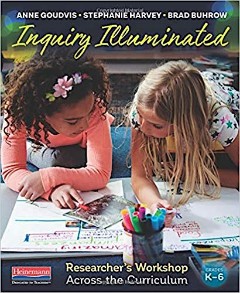Researcher’s Workshop: Science & Social Studies
Inquiry Illuminated: Researcher’s Workshop Across the Curriculum, K-6
By Anne Goudvis, Stephanie Harvey and Brad Buhrow
(Heinemann, 2019 – Learn more)

At a time when science and social studies are being squeezed out of our middle grades school week (at least in our school district) in favor of more literacy time, the Researcher’s Workshop framework offers school districts and teachers an excellent compromise.
Inquiry Illuminated shows teachers how to blend personalized learning, content area instruction, and literacy instruction into a cohesive, manageable block of time where students are self-directed and the teacher in grades 4-5 is freed up to work with small groups and give immediate feedback.

The teacher presents mini lessons that help students increase their knowledge and skills with research and self-guided learning, in addition to the more traditional reading and writing mini lessons.
While students are busy researching and sharing, the teacher might choose to work with guided reading or writing groups, circulate to offer students feedback on their progress, or assist students in their search for information.
As far as I can tell from the book, Researcher’s Workshop’s main goal is teaching students to become independent learners who know how to find appropriate reading content on subjects that interest them as a means of becoming more informed on their topic of interest. They demonstrate their learning through writing and conferencing with the teacher, and sharing formally and informally with their peers.
Akin to “passion time” and “genius hour”
Researcher’s Workshop, as it’s explained in Inquiry Illuminated, seems to have many similarities to “Passion Time” in our classroom (and “Genius Hour” in many other classrooms):
- Students are mainly working independently or with a partner to explore a specific interest (whether curricular or not).
- Books, websites, and other resources are either collected by the teacher, or students are empowered to find their own materials or websites.
- Students are expected to have a final product (written or otherwise). (Although the authors clearly state that, “Inquiry-Based Learning is not about a culminating project to a unit, but rather about living in a way that kids’ questions matter and about setting up classrooms that foster curiosity all day and every day.” – p. 32)
- Mini-Lessons are the main source of formal whole-class instruction.
- Conferences are the main source of individualized feedback.
On the other hand, there seem to be some aspects of Researcher’s Workshop that vary slightly from the way we do Passion Time in our classroom:
- Knowledge-acquisition seems to be more of a focus than skills-acquisition with this model. In our classroom, students are encouraged to learn how to play piano and record a recital, compare & contrast art forms and create their own, conduct a taste test and report on the results, etc.
- Writing seems to be the main form of final product in Researcher’s Workshop, and it is revised and assessed for a grade. In our classroom, students can make any final product and record a video describing their process and learning. No grade is given in Passion Time in our classroom, only feedback and the expectation of improvement over time.
A framework for inquiry
In Chapter 1, the authors of Inquiry Illuminated share their framework for inquiry (whether it be guided or independent inquiry). They use this framework throughout the entire book when providing examples at various grade levels, for various purposes. The four steps are:
- Immerse: Invite curiosity, build background, and find topics.
- Investigate: Develop questions, search for information, and discover answers.
- Coalesce: Intensify research, synthesize information, and build knowledge.
- Take Public: Share learning, demonstrate understanding & new insights, and take action.
They go on to suggest that there are six “Cornerstones of Inquiry” that foster active, spirited, all-in learning from students. When we as teachers “create an environment for inquiry that inspires kids to explore, investigate, and want to learn more,” we are providing them the opportunity to become the best learners they can become! These six cornerstones are:
- Curiosity
- Workshop
- Content
- Comprehension
- Collaboration
- Classroom Environment
While reading about these six cornerstones, I gathered dozens of fun ideas that I wanted to use in my 4th grade classroom! Things like interactive museums, discovery centers, poetry slams and simulations are all things I’d like to look into this year.
It’s in this section that the authors review their suggested structure for workshops, the gradual release of responsibility for students just beginning to use a workshop approach, and the six main comprehension strategies. They share a wonderful list of student practices that foster critical and creative thinking (p. 22). These could all be taught as mini lessons and referred to throughout the school year.
And there’s even a table that clearly explains how various “types of talk” in the classroom encourage or discourage student discussion and conversation (page 27). Finally, the authors provide some simple guidelines for how students should respectfully talk with each other and listen to each other (p. 28. The authors also include discussion prompts that help scaffold collaboration for those who need it (p. 29).
Implementing Researcher’s Workshop
In Chapter 2, the authors clearly explain how to scaffold the implementation of Researcher’s Workshop using a gradual release of responsibility model:
- Launching Inquiry (high level of teacher support)
- Guided Inquiry (less teacher support, but not yet independent)
- Independent Inquiry (student-led, teacher as a resource)
The authors describe how essential questions and enduring understandings are the basic building blocks of a well-planned inquiry-based unit. They also provide Wiggins’ and McTighe’s seven defining characteristics of a good essential question. Although teachers typically do all of this themselves, older students can and should be encouraged to work through this process when exploring a topic of personal interest.
The authors provide an excellent graphic that can help during the planning process of an Inquiry (p. 46). They suggest that after determining the enduring understandings and essential questions, teachers should consider five questions (and several sub-questions) next:
- What do we expect kids to learn and understand by the end of this inquiry?
- How will kids move towards the end goals each day?
- What materials do we need to be successful with this inquiry?
- What skills and strategies do kids need to accomplish our goals?
- How will kids demonstrate their learning throughout the inquiry?
Detailed resources
Starting on page 47, Inquiry Illustrated becomes a resource filled with mini-lessons and teacher supports, organized by purpose, that can be used throughout the year in Researcher’s Workshop. Some of the “Lessons” start out pretty basic (best for primary grades or students with no experience in a workshop setting), but quickly become universal.
Many of these strategy lessons are familiar but offer a new spin or a different perspective (e.g. Show, Don’t Tell or Responding to Others’ Work). The teacher supports are called “Practices” and give teachers directions for best practices to use within the workshop classroom. I plan to copy these pages and sort them into a binder with tabs, so I know where they are when I need them the most!
Much of the rest of the book is filled with example Inquiries at different grade levels, for different purposes. Many of the examples are from Brad Buhrow’s second grade classroom. Towards the back of the book, there is one example for each grade for first through fifth (I couldn’t find a sixth grade example, but I might have missed it).
I absolutely loved this book for many reasons:
- Researcher’s Workshop has the potential to make Reader’s and Writer’s Workshop much more enjoyable for students who aren’t natural readers and writers.
- It takes student interests and choice into account, which our current learning climate doesn’t consistently do.
- Encouraging student-led practices and purposeful collaboration in the classroom are the best ways to develop independent thinkers and students who know how to learn (rather than students who just know how to play the game of school).
- Finding additional ways to have the teacher step off the stage (through mini lessons & conferencing) and allow students to discover information and develop skills on their own, means more time for authentic learning and less time to be bored and tuned out.
- It means more science and social studies than otherwise possible for me!
The only thing I would have liked to have seen were more examples in an intermediate classroom. I also would have enjoyed having a CD or website to print out the lessons rather than needing to copy them. Minor complaints! I hope you’ll check out Inquiry Illuminated as soon as you can. It has the potential to make a huge impact on student engagement, happiness at school, and desire to learn.
Paul Solarz is a 4th grade teacher in Arlington Heights, Illinois. A teacher for the past twenty years, Paul was named a Top 50 Finalist for the Global Teacher Prize (Varkey Foundation), Illinois Educator of the Year (ICE), and also wrote the book, Learn Like a PIRATE. In #LearnLAP, teachers discover practical strategies for creating a student-led classroom in which students are inspired and empowered to take charge of their learning experience. (Learn Like a PIRATE is reviewed here at MiddleWeb.)


































